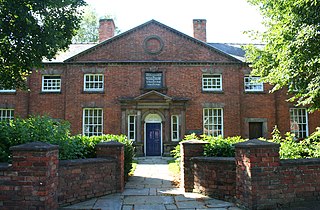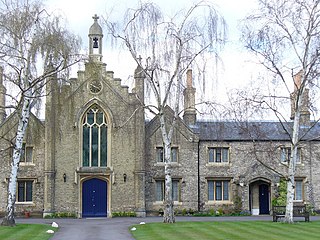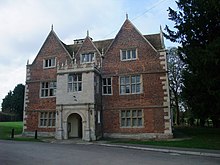
Bourne is a market town and civil parish in the South Kesteven district of Lincolnshire, England. It lies on the eastern slopes of the limestone Kesteven Uplands and the western edge of the Fens, 11 miles north-east of Stamford, 12 miles west of Spalding and 17 miles north of Peterborough. The population at the 2011 census was 14,456. A 2019 estimate put it at 16,780.

Milton Abbas is a village and civil parish in Dorset, England, lying around 5 miles southwest of Blandford Forum. In the 2011 Census the civil parish had a population of 755.

Bourne Eau is a short river which rises from an artesian spring in the town of Bourne in Lincolnshire, England, and flows in an easterly direction to join the River Glen at Tongue End. Within the town, it once powered three water mills, one of which is now a heritage centre. At Eastgate, it becomes much wider as it was navigable in the 18th and 19th centuries, and this was the location of the terminal basin. Below the town it is an embanked river, as its normal level is higher than that of the surrounding Fens. Navigation ceased in the 1860s and the river now forms an important part of the drainage system that enables the surrounding fen land to be used for agriculture.

Cerne Abbey was a Benedictine monastery founded in 987 in the town now called Cerne Abbas, Dorset, by Æthelmær the Stout.

Bourne Castle was in the market town of Bourne in southern Lincolnshire.

Edwardstone is a village and civil parish in the Babergh district, in the county of Suffolk, England. The parish contains the hamlets of Mill Green, Priory Green, Round Maple and Sherbourne Street, and Edwardstone Woods, a Site of Special Scientific Interest. The parish touches Boxford, Great Waldingfield, Groton, Little Waldingfield, Milden and Newton.

Crewe Almshouses or Crewe's Almshouses is a terrace of seven former almshouses at the end of Beam Street in Nantwich, Cheshire, England. The present building was erected in 1767 by John Crewe, later first Baron Crewe, and is listed at grade II. It has a central projecting section topped by a pediment, with a stone doorway flanked with Tuscan columns. The present almshouses stand on the site of a 16th-century building, originally the mansion of the Mainwaring family and later the town's House of Correction and workhouse.

Wright's Almshouses is a terrace of six former almshouses now located on Beam Street in Nantwich, Cheshire, England. The building was originally erected at the junction of Hospital Street and London Road in 1638 by Edmund Wright, Lord Mayor of London in 1640–41, and is listed at grade II*. The low red-brick terrace has stone dressings and a central stone panel with arms. The adjacent stone archway of 1667, which Nikolaus Pevsner describes as the "best" feature of the almshouses, is also listed separately at grade II*, together with its associated wall.

Rivington in the Borough of Chorley, Lancashire, is situated on the edge of the West Pennine Moors, at the foot of Rivington Pike overlooking reservoirs created for Liverpool Corporation Waterworks in the 19th century. There are twenty eight listed buildings within Rivington, two are classified by English Heritage as Grade II*, the rest as Grade II; Rivington has no Grade I Listed buildings.

Hickey's Almshouses are almshouses between Sheen Road and St Mary's Grove in Richmond, London.

Ince is a civil parish in Cheshire West and Chester, England. It contains 25 buildings that are recorded in the National Heritage List for England as designated listed buildings. One is these is of these listed at Grade I, the highest grade, one at Grade II*, the middle grade, and the rest are at the lowest grade, Grade II.
Brereton is a civil parish in Cheshire East, England. It contains 21 buildings that are recorded in the National Heritage List for England as designated listed buildings. Of these, one is listed at Grade I, the highest grade, three are listed at Grade II*, the middle grade, and the others are at Grade II. The parish is almost entirely rural. The major building in the parish is Brereton Hall. The listed buildings consist of the hall and associated buildings, the church and a sundial in its churchyard, a public house, a former mill, farmhouses and farm buildings, houses or cottages, and three mileposts.
Barton is a civil parish in the City of Preston, Lancashire, England. It contains ten listed buildings that are recorded in the National Heritage List for England. Of these, one is at Grade II*, the middle grade, and the others are at Grade II, the lowest grade. The parish contains the village of Barton and surrounding countryside. Running through it is the Lancaster Canal, and a bridge crossing it and an aqueduct are listed. The other listed buildings include farm buildings, milestones, a church, and a cross.
Ribchester is a civil parish in Ribble Valley, Lancashire, England. It contains 23 listed buildings that are recorded in the National Heritage List for England. Of these, one is listed at Grade I, the highest of the three grades, one is at Grade II*, the middle grade, and the others are at Grade II, the lowest grade. The parish contains the village of Ribchester, and surrounding countryside. Most of the listed buildings are houses and associated structures, or farmhouses and farm buildings, some of which are in the village, and others are in the rural area. The other listed buildings are two churches, a presbytery, a sundial, a public house with a mounting block outside, a bridge, and almshouses with a wellhead in the grounds.
Whalley is a civil parish in Ribble Valley, Lancashire, England. It contains 29 listed buildings that are recorded in the National Heritage List for England. Of these, three are listed at Grade I, the highest of the three grades, one is at Grade II*, the middle grade, and the others are at Grade II, the lowest grade. The parish contains the small town of Whalley and surrounding countryside. The town has a long history and this is reflected in the oldest listed buildings, the parish church and the abbey. Most of the other listed buildings consist of houses and shops in the town. In addition there are two public houses, a sundial in the churchyard, a former school, a former corn mill, a war memorial and, outside the town, farmhouses and farm buildings, and a railway viaduct.
Littleborough is a town in the Metropolitan Borough of Rochdale, Greater Manchester, England, and it is unparished. The town, its suburbs of Calderbrook and Smithy Bridge, and the surrounding countryside contain 79 listed buildings that are recorded in the National Heritage List for England. Of these, five are listed at Grade II*, the middle grade, and the others are at Grade II, the lowest grade. The area is largely rural, and most of the listed buildings are houses and associated structures, farmhouses, and farm buildings. Following the Industrial Revolution textile mills were built, some of which remain and are listed. The Rochdale Canal passes through the area and bridges and locks associated with it are listed. Also passing through the area was the Manchester and Leeds Railway, and structures associated with it are listed. The other listed buildings include churches, public houses, a former toll house, a bandstand, a drinking fountain, and two war memorials.
Stalybridge is a town in Tameside, Greater Manchester, England. The town, together with the village of Millbrook and the surrounding countryside, contains 55 listed buildings that are recorded in the National Heritage List for England. Of these, two are listed at Grade II*, the middle grade, and the others are at Grade II, the lowest grade. Initially rural and agricultural, the cotton industry came to the area in 1776. The older listed buildings are houses, farmhouses and farm buildings, and later listed buildings include structures associated with the Huddersfield Narrow Canal, mills, public houses, schools, churches, civic buildings, a bridge, and a war memorial.
Leigh is a town in the Metropolitan Borough of Wigan, Greater Manchester, England. The town, together with its suburbs of Bedford, Westleigh and Pennington, contains 33 listed buildings that are recorded in the National Heritage List for England. Of these, four are listed at Grade II*, the middle of the three grades, and the others are at Grade II, the lowest grade.















